Ducati’s Monsters, or Mostri, are the Italian maker’s naked sport-standards with L-twin engines. In the USA for 2008, they range from the air-cooled 695 and S2R1000 with two valves per cylinder, up to the liquid-cooled S4R S Tricolore with four valves per and a rapido 130 horsepower.
All have desmodromic valve actuation like Ducati’s super- and sportbike ranges, which can require complex valve adjustments, though Ducati says that its 2008 models “require less frequent service, less parts and labor during each service and, as a result, have greatly reduced scheduled maintenance costs.” Hallelujah!
That said, the competition from other European makers has been ramping up, and the time has come for a fully souped-up Lil’ Monster with which Ducati can do battle as well as give current fans an upgrade path. Enter the 2009 696, which features a new frame and suspension, more powerful engine and sharp, contemporary styling.
As bore and stroke remain unchanged from the 695, that one cc of additional displacement is either a figment of marketing imagination or can be found split between the new cylinder heads, which are similar to those on the 1100 2V engine in the Multistrada and Hypermotard. These bump horsepower in the 696 a claimed 9 percent, to 80 at the crank, and torque 11 percent to 50.6 lb-ft. This is the best horsepower-per-liter output of all of its air-cooled bikes, says Ducati. New cylinder fins also provide better cooling, and to save weight camshafts spin directly on bearing surfaces in the heads now rather than on rollers.
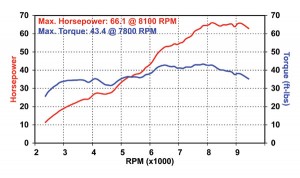
On the Jett Tuning Dynojet dyno at the rear wheel the lil’ Monster cranked out a tidy 66 horsepower at 9,100 rpm, just a tick under its 9,400-rpm redline. Torque output reached 43.4 lb-ft at 7,800. Neither number is especially impressive on its own, but pair it with the bike’s light 409-pound wet weight, and the velocity possibilities suddenly become clearer.
To also tidy up the 696’s handling, Ducati gave it a stronger frame, a hybrid version of its famous trellis supported at center by the solid-mounted engine. Up front, larger-diameter steel tubes that are lighter and stiffer than the 695’s comprise the main frame trellis. It overlaps midengine with a new cast-aluminum seat subframe styled to complement the footpeg hangers and braced, hollow aluminum swingarm, both of which bolt to the engine. Even with 2/10ths of a gallon more fuel on board–about 1.2 pounds–the 696 weighs 10 pounds less than the 695 on our scale primarily because of this new frame design, which contributes to its narrow waist and low seat.
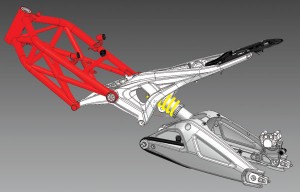
Squat, angular, purposeful; seemingly ready to come to life as some anime character’s attack dog, the 696’s styling is a huge leap forward, from its triple-parabola headlight back to the LED taillight. Hidden beneath the detachable plastic tank skin–easily painted or replaced, even with custom skin versions–is a larger volume airbox and bigger fuel cell. Those mesh-covered scoops in the tank flow air to the airbox, and also allow the bars to turn more without switchgear hitting the tank. Sorry, magnetic tankbags won’t stick, and those high twin mufflers that contribute to looks and take heat away from the rider also prevent the use of saddlebags. Nessun problema–a seatbag and strap-on tankbag work well. Pop off the sleek, armorlike pillion cowl and you’ll have to look underneath the fender to see the passenger grab handles cast into the rear subframe.
Sit on the 696 and close your eyes. Despite its width, the flat tubular handlebar leans you forward and positions your hands down about waist level, putting substantial weight on your wrists through locked elbows. Unlock your arms and now your stomach muscles hold you upright and give your wrists a break. The seat is low but is a scooped affair that slides most riders into the back of the tank, fine and dandy till you hit a big bump and are rewarded with a falsetto voice. We didn’t try it, but Ducati’s accessory touring seat may be a must, even if it is a touch higher. Legs on sub-6-footers are not as cramped as you might imagine, and the shift and brake pedals are well positioned and easy to adjust. Ducati only provides a set screw for adjusting the brake lever in tiny increments up at the bar; the same screw on the clutch side is glued in place.
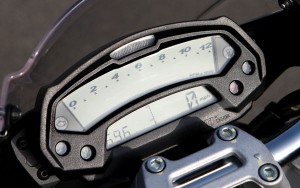
Overall the bike is compact, ultra-easy to maneuver and park, and the rider becomes one with the compactness once underway–even the thin seat padding doesn’t intrude. There’s not much moving around allowed, however, so don’t plan on making the 696 your primary sport-touring bike unless it feels big to you.
Once fired up you can ride off easily on the 696, leaving the fast idle control on for a bit till it warms, then the bike offers a responsive throttle and a very cammy, performance-oriented idle. Shifting is smooth and clean at the shift lever, though the clutch doesn’t engage until the lever is nearly all the way out and requires a bit of slipping from stops. Get on the gas hard and bang up through the gears and your life will be forever changed by the sweet music that emerges from those twin mufflers–the 696 sounds every bit as good as its larger siblings, maybe even better, thanks to the higher pitch of its smaller cylinders. Power output and acceleration will be just dandy for lighter, less aggressive riders, though hauling my 210-pound bulk up a twisting canyon at 8√ö10ths, even keeping the revs up I still had to wonder if the optional titanium exhaust kit with performance ECU chip would help the bike’s gish drive out of low-speed uphill corners.
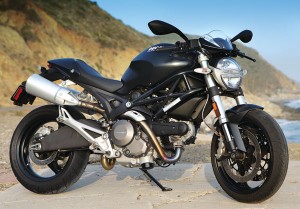
Turn around at the top and head back down, though, and the wondering ceases. The stiff new chassis, well-calibrated suspension, great brakes and light weight make the 696 a real law breaker down a twisting canyon road, and I’m talking about the laws of physics, not traffic. It just keeps leaning and leaning and leaning, never scraping anything, easily soaking up undulations in the pavement that would throw other bikes off-line, and accepting full braking force up front without a squirm before driving out of even the tightest corners straight and true. I had to have the grin surgically removed, it’s that much effortless fun. Part of the light, flickable handling is due to the narrower 160 tire on the back rather than the 180 norm, paired with the usual 120 up front.
Even Ducatis with fully adjustable suspension can be tough to coax a good ride out of, so we were surprised by the nice stock calibration of the 696’s non-adjustable male-slider Showa fork. Though it behaves like the taut shocks on a serious sports car on the freeway and jars you a bit, elsewhere the fork is just great. Like the rear suspension it especially loves smooth, undulating pavement, but does well enough on old blacktop with lots of bumps at maintaining control. The Sachs single shock in back has progressive linkage and adjustable rebound damping; once we got the inconvenient ring-and-locknut spring preload banged into place it worked well, too. Both ends have plenty of travel for such a small bike, and shouldn’t need any TLC or replacement for quite awhile.
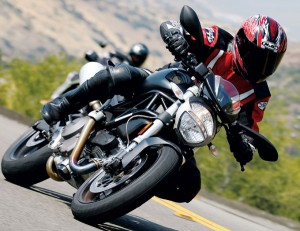
Braking is by first-rate Brembo clampers front and rear, with radial caliper mounting up front that looks purposeful. Feel at the front lever is strong and linear, but I have to sing the praises of the rear brake, which for once is neither wooden feeling at the pedal nor grabby, with good linear response over a decent travel range and enough power without locking easily.
The goody bag includes an instrument panel that does everything but your taxes, with an LCD bar graph tach, digital speedo, the usual indicators plus scheduled maintenance and lap time, and a shift and over-rev light. Helmet hooks are under the locking seat, which has a tiny amount of storage space, and there’s an oil level sight glass. Mirrors are nice looking but seem flimsy and shake at most speeds.
Among all of the new Ducatis I’ve ridden in the past 24 years, this new 2009 Monster 696 ranks as one of my all-time favorites. It looks great, has a relatively low seat height, better power-to-weight ratio than the original Monster 900 and much improved performance and handling over its heavier 695 predecessor. This flickable little 696 flea makes both a trick canyon carver for average-sized and smaller riders, and a fine entry-level machine for someone who doesn’t want to grow out of their investment. Viva Italia!
If you’re interested in the 2009 Ducati Monster 696, you might also be interested in checking out nine additonal standard motorcycles for new motorcycle riders








